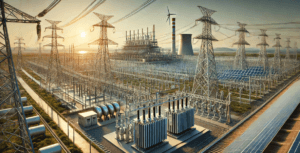Adani Wins $324M Deal to Power India’s Green Hydrogen Revolution!
Adani Energy Solutions has secured a $324 million contract for a power transmission project in Gujarat, India, aimed at supplying electricity to a green hydrogen and ammonia production facility in Mundra. Expected to be completed within three years, the project includes upgrading the Navinal substation with two large 765/400kV transformers and constructing a 75km high-voltage transmission line to connect it to the Bhuj substation. Once finished, it will add 150 circuit kilometers of power lines and 3,000 MVA of transformation capacity.
India has set a goal to produce five million tonnes of green hydrogen annually by 2030, supporting this initiative with subsidies for nine companies, including major recipients AM Green Ammonia and Waaree Clean Energy Solutions. Under its SIGHT Programme, the government has allocated $259 million to support the production of 450,000 tonnes of green hydrogen per year, reinforcing India’s commitment to clean energy and sustainability.

Adani Wins $324M Deal to Power India’s Green Hydrogen Revolution!
Adani Energy Solutions has secured a $324 million contract to develop a major power transmission project in Gujarat, India. This initiative aims to supply electricity to a green hydrogen and ammonia production plant in Mundra and is scheduled for completion within three years. As part of the project, the company will upgrade the Navinal electrical substation by installing two high-capacity transformers (765/400kV) and constructing a 75-kilometer high-voltage transmission line to connect it to the Bhuj substation. Once operational, the upgraded infrastructure will add 150 circuit kilometers of power lines and expand the region’s power transformation capacity by 3,000 MVA (megavolt-amperes), strengthening Gujarat’s energy grid.
This project plays a crucial role in advancing India’s renewable energy goals. The green hydrogen and ammonia facility in Mundra aligns with the country’s target of producing five million tonnes of green hydrogen annually by 2030. Green hydrogen, generated using renewable energy sources like wind and solar, is considered a clean alternative to fossil fuels. Ammonia, derived from this hydrogen, has applications in fertilizers, industrial processes, and even as a fuel. By powering such facilities with renewable energy, India aims to reduce carbon emissions and enhance energy independence.
To accelerate this transition, the Indian government recently awarded subsidies to nine companies under its green hydrogen initiative. Among the top beneficiaries were AM Green Ammonia and Waaree Clean Energy Solutions, which received significant financial support to expand production. These subsidies fall under the Strategic Interventions for Green Hydrogen Transition (SIGHT) Programme, which has allocated approximately $259 million to support the annual production of 450,000 tonnes of green hydrogen. This funding will help companies establish manufacturing units, implement advanced technologies, and lower production costs, making green hydrogen more commercially viable.
Adani’s transmission project serves as a cornerstone of this broader strategy. The upgraded Navinal substation and new transmission lines will ensure a reliable flow of renewable electricity to the Mundra facility, enabling large-scale green hydrogen production. Gujarat, with its abundant solar and wind resources, is emerging as a key hub for renewable energy projects. By expanding transmission networks and connecting key substations, the state can efficiently distribute clean energy to industries and households, reducing reliance on coal and other polluting energy sources.
The project’s impact extends beyond Gujarat, setting a precedent for integrating renewable energy infrastructure with industrial applications. It demonstrates how clean power can drive sustainable manufacturing. For instance, green ammonia produced in Mundra could be exported to countries seeking to decarbonize sectors such as shipping and agriculture. This positions India as a potential global supplier of green energy products while creating jobs and stimulating economic growth.
Adani Energy Solutions, a subsidiary of the Adani Group, has been actively expanding its renewable energy portfolio. The company’s expertise in developing and managing power transmission networks will be critical in overcoming the technical challenges of this project. High-voltage transmission lines, such as the one planned between Navinal and Bhuj, minimize energy loss over long distances, ensuring efficient power delivery. Additionally, the new transformers at Navinal will enhance grid stability, prevent outages, and support the integration of variable renewable energy sources like solar and wind.
India’s green hydrogen mission faces challenges, including high production costs and the need for advanced infrastructure. However, initiatives like the SIGHT Programme and collaborations with private sector companies aim to address these hurdles. By subsidizing early-stage projects, the government hopes to attract investment, encourage innovation, and build a competitive green hydrogen ecosystem. Success in Gujarat could inspire similar projects across the country, helping India meet its 2030 target and strengthen its position in the global clean energy market.
In summary, Adani’s $324 million transmission project is more than just an infrastructure upgrade—it is a crucial component of India’s renewable energy strategy. By facilitating green hydrogen production, it supports the country’s climate goals, reduces fossil fuel dependence, and paves the way for sustainable industrial growth. With government backing and private sector participation, projects like this underscore India’s commitment to a greener future.
You must be logged in to post a comment.